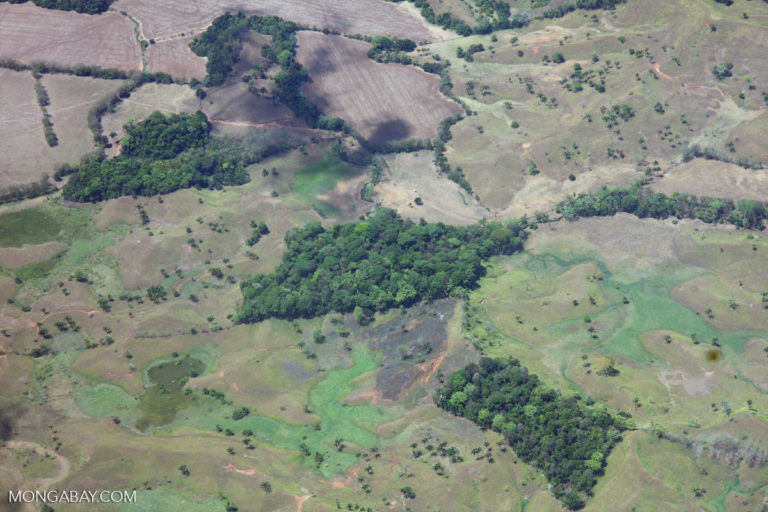- Tropical forest areas made smaller by land use and roads lost more than 11% tree cover every year over an 18-year period
- Larger blocks of forest lost about 2% of their trees per year over the same time period
- Researchers fear further losses are likely unless efforts are made to reforest larger areas and limit future fragmentation
Smaller fragments of tropical forest experienced forest loss at a greater rate than larger blocks between 2001 and 2018, researchers have found, prompting calls for restorative measures to be taken to increase cover in highly fragmented areas.
According to a statement released in conjunction with the report, which was published in Science Advances last week, the researchers identified forest fragments with a minimum size of 10-square-kilometers starting in 2000, and analyzed how much tree cover was lost in each of these fragments over the next 18 years, converting the loss into a percentage of the overall original fragment size.

They found that the smaller the forest fragments, the higher the rate of deforestation in those areas. Co-author Matthew C. Hansen attributed “all land use,” such as for agricultural purposes, and roads, which “generally open up forest for exploitation,” as key factors causing fragmentation across all the tropical forest areas that they studied. Logging plays a part, he said, but is not necessarily as definitive as full-scale clearance in order to repurpose the land for crop plantations.
“Smaller chunks of forest experienced proportionally higher losses, with the 36,282 smallest fragments (under 675 square kilometers, or 260 square miles) losing 11.5% of their tree cover each year, while the 22 largest stretches (greater than 75,000 square kilometers, or 28,957 square miles) lost 2% each year,” the study found.
Geographically, the researchers identified Central America, West Africa and Southeast Asia as areas where fragmentation has resulted in forest loss and “where contiguous natural forest blocks are absent.”
Hansen told Mongabay that Guatemala, Ivory Coast and Cambodia are three of the countries whose smaller fragmented tropical forests had fared the worst.
“When you get down to a few remaining fragments in a country and you’re still not developed, meaning you could put [a] rubber [plantation] in a wildlife refuge, re-gazetting a wildlife refuge, you’re going to do that. In Ivory Coast there’s a national park that’s now [a] cacao [plantation].”
In Cambodia, the report said, “large areas within wildlife sanctuaries, conservation areas, and national parks have been replaced with commercial rubber plantations in recent years,” while in Guatemala there was a “marked loss in Sierra del Lancadon and Laguna del Tigre National Parks.”

Hansen acknowledged Hansen acknowledged that different factors and contexts are at play in different locales.
In Papua New Guinea for instance, which has tropical rainforest cover, some analysts say that the country’s lack of infrastructure has actually helped drive forest fragmentation in some cases.
According to Peter Dam the technical advisor for FORCERT, an NGO that focuses on community based sustainable forest management in Papua New Guinea, there’s a fine balance between protecting these fragile forest fragments while enabling communities to be better connected.
“I think for Papua New Guinea, we have quite a specific situation,” he told Mongabay on Thursday. “Because land ownership is customary and recognized in the constitution, so the communities own their land. The problem is, they lack infrastructure.”
As a result, Dam said, some communities “may invite logging companies in, because they think the company will bring them the road access they need to the outside world, or the next town,” he said, which can lead to increased forest clearance, but a road that doesn’t necessarily lead to where the communities need it to.
According to the research paper, “tropical areas without large fragments, including Central America, West Africa, and mainland Southeast Asia, have higher loss within and outside of protected areas”
“Results illustrate the need for rigorous land use planning, management, and enforcement in maintaining large tropical forest fragments and restoring regions of advanced fragmentation.”
The authors wrote that “the fate of tropical forest fragments is one of likely continued loss,” unless efforts are made to re-establish “large blocks of natural forest cover,” while implementing measures – such as certifying logging concessions – to limit further fragmentation of existing forests.
Banner image: Forest fragmentation in the Brazilian Amazon. Photo by Rhett A. Butler / Mongabay
Citation: Matthew C. Hansen, Lei Wang, Xiao-Peng Song, Alexandra Tyukavina, Svetlana Turubanova, Peter V. Potapov and Stephen V. Stehman
Science Advances 11 Mar 2020:
Vol. 6, no. 11, eaax8574
DOI: 10.1126/sciadv.aax8574
